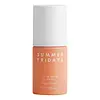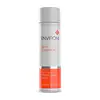What's inside
What's inside
 Key Ingredients
Key Ingredients

 Benefits
Benefits

 Concerns
Concerns

 Ingredients Side-by-side
Ingredients Side-by-side

Water
Skin ConditioningNiacinamide
SmoothingButylene Glycol
Humectant3-O-Ethyl Ascorbic Acid
Skin ConditioningAscorbyl Glucoside
AntioxidantGlycerin
HumectantCapryloyl Glycerin/Sebacic Acid Copolymer
Skin ConditioningHydroxyethyl Acrylate/Sodium Acryloyldimethyl Taurate Copolymer
Emulsion StabilisingSqualane
EmollientSodium Citrate
BufferingPhenoxyethanol
PreservativeSodium Hydroxide
BufferingCitric Acid
BufferingDiheptyl Succinate
EmollientTocopheryl Acetate
AntioxidantXanthan Gum
EmulsifyingTetrasodium Glutamate Diacetate
Carbomer
Emulsion StabilisingPolysorbate 20
EmulsifyingPalmitoyl Oligopeptide
CleansingPalmitoyl Tetrapeptide-7
Skin ConditioningCamellia Oleifera Leaf Extract
AstringentEthylhexylglycerin
Skin ConditioningOrchis Mascula Flower Extract
SoothingCaprylic/Capric Triglyceride
MaskingCananga Odorata Flower Extract
PerfumingCucumis Melo Cantalupensis Fruit Extract
AstringentEugenia Caryophyllus Flower Extract
AstringentGlycine Soja Oil
EmollientPyrus Malus Fruit Extract
Skin ConditioningPrunus Armeniaca Fruit Extract
Skin ConditioningRosa Gallica Flower Extract
AstringentCinnamomum Cassia Bark Extract
MaskingJasminum Officinale Flower/Leaf Extract
MaskingCoffea Arabica Leaf/Seed Extract
MaskingCamellia Sinensis Leaf Extract
AntimicrobialAmyl Cinnamal
PerfumingCinnamyl Alcohol
PerfumingCitronellol
PerfumingEugenol
PerfumingHydroxycitronellal
PerfumingWater, Niacinamide, Butylene Glycol, 3-O-Ethyl Ascorbic Acid, Ascorbyl Glucoside, Glycerin, Capryloyl Glycerin/Sebacic Acid Copolymer, Hydroxyethyl Acrylate/Sodium Acryloyldimethyl Taurate Copolymer, Squalane, Sodium Citrate, Phenoxyethanol, Sodium Hydroxide, Citric Acid, Diheptyl Succinate, Tocopheryl Acetate, Xanthan Gum, Tetrasodium Glutamate Diacetate, Carbomer, Polysorbate 20, Palmitoyl Oligopeptide, Palmitoyl Tetrapeptide-7, Camellia Oleifera Leaf Extract, Ethylhexylglycerin, Orchis Mascula Flower Extract, Caprylic/Capric Triglyceride, Cananga Odorata Flower Extract, Cucumis Melo Cantalupensis Fruit Extract, Eugenia Caryophyllus Flower Extract, Glycine Soja Oil, Pyrus Malus Fruit Extract, Prunus Armeniaca Fruit Extract, Rosa Gallica Flower Extract, Cinnamomum Cassia Bark Extract, Jasminum Officinale Flower/Leaf Extract, Coffea Arabica Leaf/Seed Extract, Camellia Sinensis Leaf Extract, Amyl Cinnamal, Cinnamyl Alcohol, Citronellol, Eugenol, Hydroxycitronellal
Water
Skin ConditioningSorbitol
HumectantButylene Glycol
HumectantSodium Lactate
BufferingPanthenol
Skin ConditioningSodium PCA
HumectantNiacinamide
SmoothingEthoxydiglycol
HumectantPropylene Glycol
HumectantGlucose
HumectantLactic Acid
BufferingChamomilla Recutita Flower Extract
MaskingAchillea Millefolium Extract
CleansingOnonis Spinosa Root Extract
AntiseborrhoeicTussilago Farfara Leaf Extract
AstringentRosmarinus Officinalis Leaf Extract
AntimicrobialThymus Serpyllum Extract
Skin ConditioningSalvia Officinalis Leaf Extract
CleansingMelissa Officinalis Leaf Extract
Skin ConditioningEquisetum Arvense Extract
AstringentAlthaea Officinalis Root Extract
Skin ConditioningCyclopia Genistoides Leaf Extract
AntioxidantDisodium EDTA
Sodium Benzoate
MaskingPotassium Sorbate
PreservativeCaramel
Cosmetic ColorantCitric Acid
BufferingWater, Sorbitol, Butylene Glycol, Sodium Lactate, Panthenol, Sodium PCA, Niacinamide, Ethoxydiglycol, Propylene Glycol, Glucose, Lactic Acid, Chamomilla Recutita Flower Extract, Achillea Millefolium Extract, Ononis Spinosa Root Extract, Tussilago Farfara Leaf Extract, Rosmarinus Officinalis Leaf Extract, Thymus Serpyllum Extract, Salvia Officinalis Leaf Extract, Melissa Officinalis Leaf Extract, Equisetum Arvense Extract, Althaea Officinalis Root Extract, Cyclopia Genistoides Leaf Extract, Disodium EDTA, Sodium Benzoate, Potassium Sorbate, Caramel, Citric Acid
 Reviews
Reviews

Ingredients Explained
These ingredients are found in both products.
Ingredients higher up in an ingredient list are typically present in a larger amount.
Butylene Glycol (or BG) is used within cosmetic products for a few different reasons:
Overall, Butylene Glycol is a safe and well-rounded ingredient that works well with other ingredients.
Though this ingredient works well with most skin types, some people with sensitive skin may experience a reaction such as allergic rashes, closed comedones, or itchiness.
Learn more about Butylene GlycolCitric Acid is an alpha hydroxy acid (AHA) naturally found in citrus fruits like oranges, lemons, and limes.
Like other AHAs, citric acid can exfoliate skin by breaking down the bonds that hold dead skin cells together. This helps reveal smoother and brighter skin underneath.
However, this exfoliating effect only happens at high concentrations (20%) which can be hard to find in cosmetic products.
Due to this, citric acid is usually included in small amounts as a pH adjuster. This helps keep products slightly more acidic and compatible with skin's natural pH.
In skincare formulas, citric acid can:
While it can provide some skin benefits, research shows lactic acid and glycolic acid are generally more effective and less irritating exfoliants.
Most citric acid used in skincare today is made by fermenting sugars (usually from molasses). This synthetic version is identical to the natural citrus form but easier to stabilize and use in formulations.
Read more about some other popular AHA's here:
Learn more about Citric AcidNiacinamide is a multitasking form of vitamin B3 that strengthens the skin barrier, reduces pores and dark spots, regulates oil, and improves signs of aging.
And the best part? It's gentle and well-tolerated by most skin types, including sensitive and reactive skin.
You might have heard of "niacin flush", or the reddening of skin that causes itchiness. Niacinamide has not been found to cause this.
In very rare cases, some individuals may not be able to tolerate niacinamide at all or experience an allergic reaction to it.
If you are experiencing flaking, irritation, and dryness with this ingredient, be sure to double check all your products as this ingredient can be found in all categories of skincare.
When incorporating niacinamide into your routine, look out for concentration amounts. Typically, 5% niacinamide provides benefits such as fading dark spots. However, if you have sensitive skin, it is better to begin with a smaller concentration.
When you apply niacinamide to your skin, your body converts it into nicotinamide adenine dinucleotide (NAD). NAD is an essential coenzyme that is already found in your cells as "fuel" and powers countless biological processes.
In your skin, NAD helps repair cell damage, produce new healthy cells, support collagen production, strengthen the skin barrier, and fight environmental stressors (like UV and pollution).
Our natural NAD levels start to decline with age, leading to slower skin repair, visible aging, and a weaker skin barrier. By providing your skin niacinamide, you're recharging your skin's NAD levels. This leads to stronger, healthier, and younger looking skin.
Another name for vitamin B3 is nicotinamide. This vitamin is water-soluble and our bodies don't store it. We obtain Vitamin B3 from either food or skincare. Meat, fish, wheat, yeast, and leafy greens contain vitamin B3.
The type of niacinamide used in skincare is synthetically created.
Learn more about NiacinamideWater. It's the most common cosmetic ingredient of all. You'll usually see it at the top of ingredient lists, meaning that it makes up the largest part of the product.
So why is it so popular? Water most often acts as a solvent - this means that it helps dissolve other ingredients into the formulation.
You'll also recognize water as that liquid we all need to stay alive. If you see this, drink a glass of water. Stay hydrated!
Learn more about Water